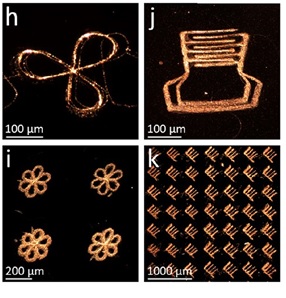Electrohydrodynamic printing
Electrohydrodynamic printing consists in collecting electrospun fiber to define patterns and 3D objects. It is also often called near-field electrospinning, or NFES, because the substrate is positioned very close to the spinning tube supplying the liquid. As in electrospinning, a strong electric field is applied to a viscous polymer solution or melt, and the resulting fiber is extremely thin, with a width typically under one or two micrometers.
Jet-deflection EHD printing
The jet is electrostatically stirred in the transversal dimensions, producing controlled patterns on the substrate. This must be done at high enough speeds so the fiber does not pile up on the substrate. It allows printing straight fiber on slow moving substrates or even stationary ones.
 |
 |
|
Nature Communications (2020) |
Materials & Design (2021) |
